It looks like you're using an Ad Blocker.
Please white-list or disable AboveTopSecret.com in your ad-blocking tool.
Thank you.
Some features of ATS will be disabled while you continue to use an ad-blocker.
share:
No, this isn't about waiting for the next release of photos of NASA's Dawn spacecraft. Everyone is a bit on edge waiting. No, this is something
else entirely.
There has been a GIF file circulating that reports to depict a entire rotation of the Dwarf planet, except for one thing, it doesn't.
Here is the original GIF
photojournal.jpl.nasa.gov...
I have been looking for photos of the crater with light that show it coming from the left horizon, and there does not appear to be one.
This is the first photo of the GIF file
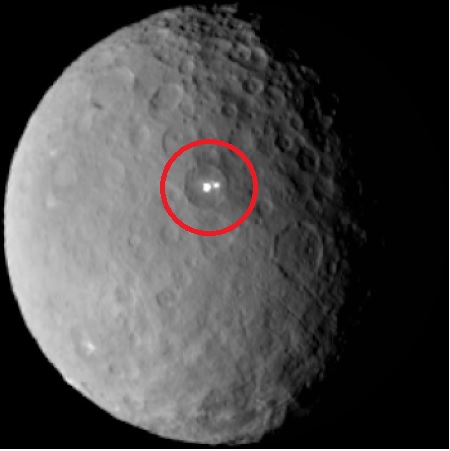
This is the last photo of the GIF file
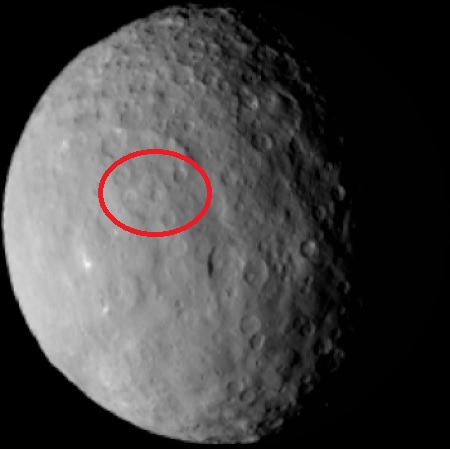
So It appears there are 4 to 7 photos missing. This GIF file does not reflect a full rotation of Ceres.
What would those photos show? They could reveal Ice Volcano's, or out gassing, or something else about the nature of this particular crater. Why not show them?
Original GIF file from NASA
photojournal.jpl.nasa.gov...
Slowed down version.
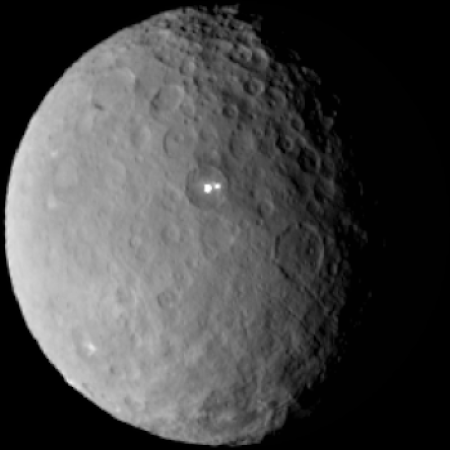
NASA, you have some explaining to do!
There has been a GIF file circulating that reports to depict a entire rotation of the Dwarf planet, except for one thing, it doesn't.
Here is the original GIF
Dawn observed Ceres for a full rotation of the dwarf planet, which lasts about nine hours
photojournal.jpl.nasa.gov...
I have been looking for photos of the crater with light that show it coming from the left horizon, and there does not appear to be one.
This is the first photo of the GIF file

This is the last photo of the GIF file

So It appears there are 4 to 7 photos missing. This GIF file does not reflect a full rotation of Ceres.
What would those photos show? They could reveal Ice Volcano's, or out gassing, or something else about the nature of this particular crater. Why not show them?
Original GIF file from NASA
photojournal.jpl.nasa.gov...
Slowed down version.

NASA, you have some explaining to do!
Wait a minute. I thought the anomaly was described as a reflection of newly formed ice. Has that hypothesis been altered? That light doesn't change
one bit through the shown rotation - even when it enters the dark side...What's up with that??? Reflection my ankles.
Thank you OP, very interesting.
a reply to: All Seeing Eye
Thank you OP, very interesting.
a reply to: All Seeing Eye
NASA has a real bad habit of either not showing everything, or once they 'accidentally' show something, puling it back and denying it. While I am
super-keen on the idea of space exploration, I don't have a whole lot of trust for an organisation Jim Marrs reffered to as 'Never A Straight
Answer'.
a reply to: All Seeing Eye
So, people are speculating that the "lights" at the bottom of the crater are artificial sources and not just reflections of sunlight off ice at the bottom of that crater, right? And it does appear odd that the lights persist even 'after dark' as this screen capture 'reflects', right?

I'm sure this has been debated to death…
what I observe in the Gif is that lots of craters have ice at their bottoms (the white stuff) so that can't be counted out as a source for the reflection, even as the bright spot passes into darkness. Mountain peaks can be seen still lit by the "setting sun" in the pic.
I call reflection.
So, people are speculating that the "lights" at the bottom of the crater are artificial sources and not just reflections of sunlight off ice at the bottom of that crater, right? And it does appear odd that the lights persist even 'after dark' as this screen capture 'reflects', right?

I'm sure this has been debated to death…
what I observe in the Gif is that lots of craters have ice at their bottoms (the white stuff) so that can't be counted out as a source for the reflection, even as the bright spot passes into darkness. Mountain peaks can be seen still lit by the "setting sun" in the pic.
I call reflection.
originally posted by: donktheclown
Wait a minute. I thought the anomaly was described as a reflection of newly formed ice. Has that hypothesis been altered? That light doesn't change one bit through the shown rotation - even when it enters the dark side...What's up with that??? Reflection my ankles.
Thank you OP, very interesting.
a reply to: All Seeing Eye
My thoughts exactly.
If this 'white light' is due to reflections of some very bright material, whether that is water ice, outgassing or some unusually bright rock of some type, it would not continue to be a bright spot as it rotated around out of the sunlight.
Whatever this thing is and whatever is causing it to shine like a beacon, it is doing it itself. IOW, it seems to be self luminous and not reflected light from the Sun.
a reply to: intrptr
Hold on there partner...it doesn't have to be artificial to not be a reflection.
It could be due to a chemical reaction for example...or going out on a limb, it could even be some bizarre and as yet unknown form of bioluminescence...unlikely, but not beyond possibility.
Hold on there partner...it doesn't have to be artificial to not be a reflection.
It could be due to a chemical reaction for example...or going out on a limb, it could even be some bizarre and as yet unknown form of bioluminescence...unlikely, but not beyond possibility.
a reply to: MysterX
You see what you want to. The pic I brought clearly shows rim of the crater still 'lit' by the sun. Any reflective material (ike ice) would still be 'lit' as well.
Whatever this thing is and whatever is causing it to shine like a beacon, it is doing it itself. IOW, it seems to be self luminous and not reflected light from the Sun.
You see what you want to. The pic I brought clearly shows rim of the crater still 'lit' by the sun. Any reflective material (ike ice) would still be 'lit' as well.
a reply to: All Seeing Eye
Uhm..From the link.
There has been a GIF file circulating that reports to depict a entire rotation of the Dwarf planet, except for one thing, it doesn't.
Uhm..From the link.
This animation does not show a complete rotation, but instead shows six hours and 45 minutes of the nine-hour rotation
edit on 12-4-2015 by Mianeye because: (no reason given)
a reply to: intrptr
We all see what we see mate...otherwise we'd all be in complete agreement on these issues.
I obviously don't see the same as you or DJ, as the light, whatever is actually producing it, doesn't appear to diminish as it rounds the terminator, but remains steady - as would be the case if the light is generated locally somehow.
The animated Gif on the OP shows this is so...the reason the light disappears, is because the crater housing the light, is out of view due to rotation...IOW, we can't see it any longer, so of course, we no longer see the light.
But as you say, we'll all see what we see, it would be boring any other way in my view.
We all see what we see mate...otherwise we'd all be in complete agreement on these issues.
I obviously don't see the same as you or DJ, as the light, whatever is actually producing it, doesn't appear to diminish as it rounds the terminator, but remains steady - as would be the case if the light is generated locally somehow.
The animated Gif on the OP shows this is so...the reason the light disappears, is because the crater housing the light, is out of view due to rotation...IOW, we can't see it any longer, so of course, we no longer see the light.
But as you say, we'll all see what we see, it would be boring any other way in my view.
Look at the pic I brought. See the "little lights" around the large one? Thats the carter rim still bathed in the setting sun.
Thank you for the observation. But still, where are the missing photos that could expose more about the characteristics of the crater??? Why are they missing???
originally posted by: Mianeye
a reply to: All Seeing Eye
There has been a GIF file circulating that reports to depict a entire rotation of the Dwarf planet, except for one thing, it doesn't.
Uhm..From the link.
This animation does not show a complete rotation, but instead shows six hours and 45 minutes of the nine-hour rotation
originally posted by: intrptr
a reply to: All Seeing Eye
So, people are speculating that the "lights" at the bottom of the crater are artificial sources and not just reflections of sunlight off ice at the bottom of that crater, right? And it does appear odd that the lights persist even 'after dark' as this screen capture 'reflects', right?
I'm sure this has been debated to death…
what I observe in the Gif is that lots of craters have ice at their bottoms (the white stuff) so that can't be counted out as a source for the reflection, even as the bright spot passes into darkness. Mountain peaks can be seen still lit by the "setting sun" in the pic.
I call reflection.
As viewed casually, the crater and lights appear as though they could be a out gassing, reflective, event, as depicted in the frame you have posted. The missing photos could enhance that position, or dispel it. Now, why are they missing?
a reply to: All Seeing Eye
They never said they took pictures of a full rotation, they said "Dawn observed Ceres for a full rotation", so there are no more pictures as it didn't take more than the ones showed.
They never said they took pictures of a full rotation, they said "Dawn observed Ceres for a full rotation", so there are no more pictures as it didn't take more than the ones showed.
edit on 12-4-2015 by Mianeye because: (no reason given)
a reply to: intrptr
For clarity, i appreciate what you're seeing and your explanation of what you see.
I can indeed see the weakly lit crater rim and mountains still lit by the reflected sunlight as it meets the terminator, that isn't in question...it is there and it is exactly as you say it is.
What i am saying is taking that normal reflected sunlight into account, the bright spot inside the bottom of the crater appears to be MUCH brighter for MUCH longer than it ought to be if we were talking about reflected light from the sun.
The obvious and easy way to determine if this is actually a reflection or whether this is self luminous (somehow), is to shoot the area in question while it is in darkness...if the light is still there, then of course that would rule out a reflection in a rather definitive way.
Which brings us to the OP's original question...why are we missing the full rotation images? Why only 2/3rds of a rotation and not the full 9 hours?
Any idea if the probe be imaging the crater from the unlit side of the DP? If that shows the light is still there when in the dark side, that will really put a cat among the pigeons.
For clarity, i appreciate what you're seeing and your explanation of what you see.
I can indeed see the weakly lit crater rim and mountains still lit by the reflected sunlight as it meets the terminator, that isn't in question...it is there and it is exactly as you say it is.
What i am saying is taking that normal reflected sunlight into account, the bright spot inside the bottom of the crater appears to be MUCH brighter for MUCH longer than it ought to be if we were talking about reflected light from the sun.
The obvious and easy way to determine if this is actually a reflection or whether this is self luminous (somehow), is to shoot the area in question while it is in darkness...if the light is still there, then of course that would rule out a reflection in a rather definitive way.
Which brings us to the OP's original question...why are we missing the full rotation images? Why only 2/3rds of a rotation and not the full 9 hours?
Any idea if the probe be imaging the crater from the unlit side of the DP? If that shows the light is still there when in the dark side, that will really put a cat among the pigeons.
Really? Really?
originally posted by: Mianeye
a reply to: All Seeing Eye
They never said they took pictures of a full rotation, they said "Dawn observed Ceres for a full rotation", so there are no more pictures as it didn't take more than the ones showed.
Dawn observed Ceres for a full rotation, in what fashion does a Robot space vehicle, "Observe"?? Does it have eyes? Or a camera? Your saying these observations, were not stored, and transmitted back? Or are you saying NASA just didn't feel it necessary and a waist of time not to document the entire rotation?
So, in your opinion, we sent a space vehicle 7 years away, and had no intentions of recording everything we could, is that correct?
a reply to: All Seeing Eye
It's a bizarre situation, but i do think that is indeed what is being said.
Quite unbelievable in my opinion.
It's a bizarre situation, but i do think that is indeed what is being said.
Quite unbelievable in my opinion.
a reply to: intrptr
Some might try to say "Artificial", I do not. I believe the source of the light emitting, is Natural.
This is a magnified view of the crater in question.
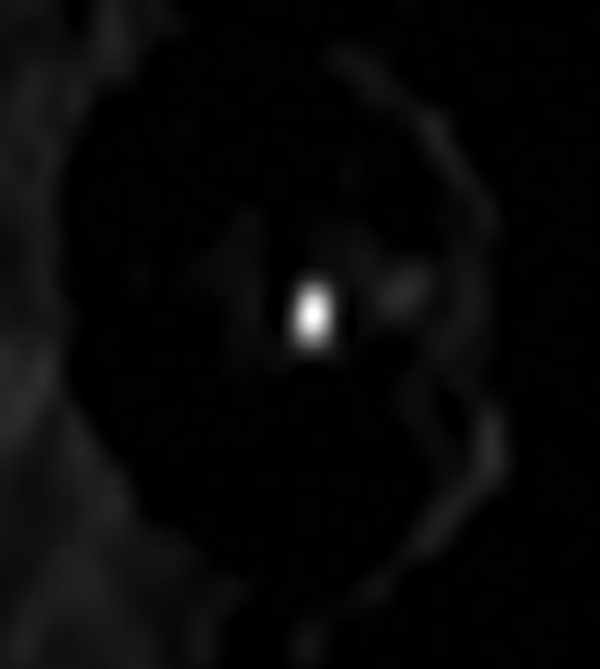
This is a light enhanced version.
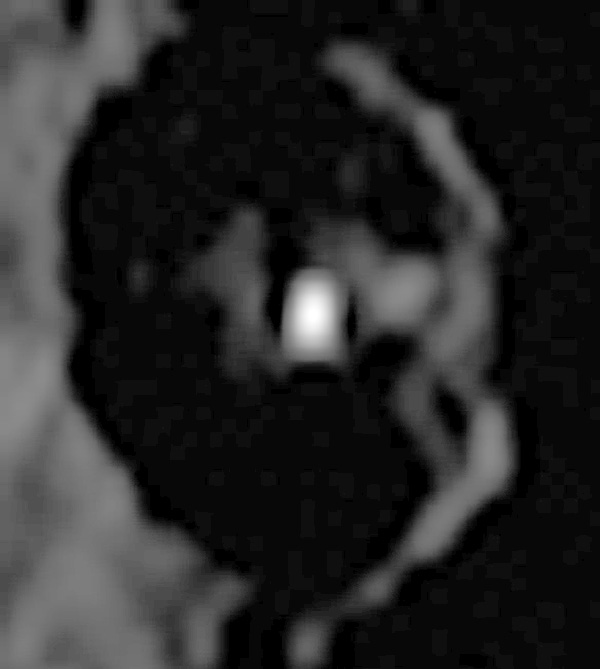
A big thank you to "Soylent Green Is People" for the enhancements.
www.abovetopsecret.com...
In the light enhanced photo the first thing you might see is the light to the right, the minor one, is actually a structure, reflecting light. In my opinion, this structure is the meteor that caused the crater. It appears as though after impact it bounced back out of the hole it just dug, and landed to the right. So, those who claim refection are half right.
To the central intense light, it must be emitting from the hole the meteor dug. It has either penetrated the crust entirely, or partially. If it opened a hole up to the interior, what you are seeing is the light of the bodies core. If it only penetrated partially, you may be seeing reflected light from ice, or some other reflective material. In either case, meteors dig holes upon impact, that is what they do.
To the concept of the light being light from the bodies core, why not. Scientists argue every day about the core of our very own planet. And since Ceres is a generally spherical body, why cant it also have a core?? Maybe, since no one has ever seen a planetary core before, and they are only theories, why don't they admit that maybe this is what we are seeing? Maybe, all planetary cores are not molten iron or lava as the theory suggest they are. Maybe, planetary cores are more like Light Emitting Diodes?
In either case, the missing photos could answer the question. Is it a reflection, or a source.
So, people are speculating that the "lights" at the bottom of the crater are artificial sources and not just reflections of sunlight off ice at the bottom of that crater, right? And it does appear odd that the lights persist even 'after dark' as this screen capture 'reflects', right?
Some might try to say "Artificial", I do not. I believe the source of the light emitting, is Natural.
This is a magnified view of the crater in question.

This is a light enhanced version.

A big thank you to "Soylent Green Is People" for the enhancements.
www.abovetopsecret.com...
In the light enhanced photo the first thing you might see is the light to the right, the minor one, is actually a structure, reflecting light. In my opinion, this structure is the meteor that caused the crater. It appears as though after impact it bounced back out of the hole it just dug, and landed to the right. So, those who claim refection are half right.
To the central intense light, it must be emitting from the hole the meteor dug. It has either penetrated the crust entirely, or partially. If it opened a hole up to the interior, what you are seeing is the light of the bodies core. If it only penetrated partially, you may be seeing reflected light from ice, or some other reflective material. In either case, meteors dig holes upon impact, that is what they do.
To the concept of the light being light from the bodies core, why not. Scientists argue every day about the core of our very own planet. And since Ceres is a generally spherical body, why cant it also have a core?? Maybe, since no one has ever seen a planetary core before, and they are only theories, why don't they admit that maybe this is what we are seeing? Maybe, all planetary cores are not molten iron or lava as the theory suggest they are. Maybe, planetary cores are more like Light Emitting Diodes?
In either case, the missing photos could answer the question. Is it a reflection, or a source.
edit on 12-4-2015 by All Seeing Eye because:
change word crater to meteor
a reply to: All Seeing Eye
Interesting theory, about the core i mean.
Who knows...and that's really the point isn't it
Besides...if that is sunlight reflected from water or CO2 ice inside that crater, it is near to the equator of the planet, with no atmospheric protection and so to be THAT bright has to be absorbing a hell of a lot of energy from the sun...it would have sublimated away in pretty short order, even if some of it condensed and refroze during night-time phases.
I don't think it's ice of any sort because of this.
If this were at the poles, on a world or moon where the full force and glare of sunlight was not directed right at that crater, i would consider ice as a real proposition..there's even water ice in some areas of the planet Mercury believe it or not, but this is in craters that are in perpetual shadow and protected from the full intensity of the sun...this crater with the extremely bright spot isn't at the poles, but close to the equator and fully exposed to the full glare of the sunlight.
There would be no ice that can survive that for any length of time.
Interesting theory, about the core i mean.
Who knows...and that's really the point isn't it
Besides...if that is sunlight reflected from water or CO2 ice inside that crater, it is near to the equator of the planet, with no atmospheric protection and so to be THAT bright has to be absorbing a hell of a lot of energy from the sun...it would have sublimated away in pretty short order, even if some of it condensed and refroze during night-time phases.
I don't think it's ice of any sort because of this.
If this were at the poles, on a world or moon where the full force and glare of sunlight was not directed right at that crater, i would consider ice as a real proposition..there's even water ice in some areas of the planet Mercury believe it or not, but this is in craters that are in perpetual shadow and protected from the full intensity of the sun...this crater with the extremely bright spot isn't at the poles, but close to the equator and fully exposed to the full glare of the sunlight.
There would be no ice that can survive that for any length of time.
new topics
-
Maestro Benedetto
Literature: 1 hours ago -
Is AI Better Than the Hollywood Elite?
Movies: 1 hours ago -
Las Vegas UFO Spotting Teen Traumatized by Demon Creature in Backyard
Aliens and UFOs: 4 hours ago -
2024 Pigeon Forge Rod Run - On the Strip (Video made for you)
Automotive Discussion: 5 hours ago -
Gaza Terrorists Attack US Humanitarian Pier During Construction
Middle East Issues: 6 hours ago -
The functionality of boldening and italics is clunky and no post char limit warning?
ATS Freshman's Forum: 7 hours ago -
Meadows, Giuliani Among 11 Indicted in Arizona in Latest 2020 Election Subversion Case
Mainstream News: 7 hours ago -
Massachusetts Drag Queen Leads Young Kids in Free Palestine Chant
Social Issues and Civil Unrest: 8 hours ago -
Weinstein's conviction overturned
Mainstream News: 9 hours ago -
Supreme Court Oral Arguments 4.25.2024 - Are PRESIDENTS IMMUNE From Later Being Prosecuted.
Above Politics: 10 hours ago
top topics
-
Krystalnacht on today's most elite Universities?
Social Issues and Civil Unrest: 10 hours ago, 9 flags -
Supreme Court Oral Arguments 4.25.2024 - Are PRESIDENTS IMMUNE From Later Being Prosecuted.
Above Politics: 10 hours ago, 8 flags -
University of Texas Instantly Shuts Down Anti Israel Protests
Education and Media: 13 hours ago, 7 flags -
Weinstein's conviction overturned
Mainstream News: 9 hours ago, 7 flags -
Gaza Terrorists Attack US Humanitarian Pier During Construction
Middle East Issues: 6 hours ago, 7 flags -
Massachusetts Drag Queen Leads Young Kids in Free Palestine Chant
Social Issues and Civil Unrest: 8 hours ago, 6 flags -
Meadows, Giuliani Among 11 Indicted in Arizona in Latest 2020 Election Subversion Case
Mainstream News: 7 hours ago, 5 flags -
Las Vegas UFO Spotting Teen Traumatized by Demon Creature in Backyard
Aliens and UFOs: 4 hours ago, 4 flags -
2024 Pigeon Forge Rod Run - On the Strip (Video made for you)
Automotive Discussion: 5 hours ago, 2 flags -
Any one suspicious of fever promotions events, major investor Goldman Sachs card only.
The Gray Area: 15 hours ago, 2 flags
active topics
-
Post A Funny (T&C Friendly) Pic Part IV: The LOL awakens!
General Chit Chat • 7135 • : underpass61 -
University of Texas Instantly Shuts Down Anti Israel Protests
Education and Media • 230 • : Xtrozero -
Nearly 70% Of Americans Want Talks To End War In Ukraine
Political Issues • 94 • : Scratchpost -
VP's Secret Service agent brawls with other agents at Andrews
Mainstream News • 62 • : ByeByeAmericanPie -
SETI chief says US has no evidence for alien technology. 'And we never have'
Aliens and UFOs • 72 • : yuppa -
My Poor Avocado Plant.
General Chit Chat • 77 • : JonnyC555 -
New whistleblower Jason Sands speaks on Twitter Spaces last night.
Aliens and UFOs • 61 • : Ophiuchus1 -
Is AI Better Than the Hollywood Elite?
Movies • 2 • : 5thHead -
Gaza Terrorists Attack US Humanitarian Pier During Construction
Middle East Issues • 25 • : CarlLaFong -
Mood Music Part VI
Music • 3102 • : Hellmutt

